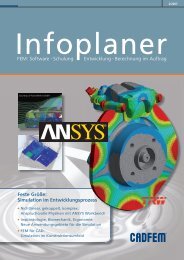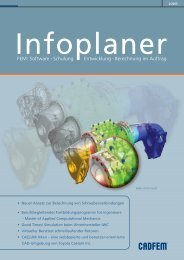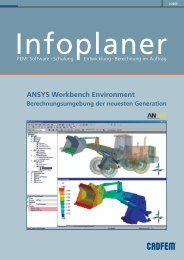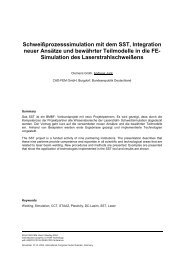You also want an ePaper? Increase the reach of your titles
YUMPU automatically turns print PDFs into web optimized ePapers that Google loves.
4<br />
� 1 � 1<br />
2 ��<br />
�� M q �<br />
��<br />
� �o<br />
� g<br />
��<br />
0<br />
Background on <strong>Acoustics</strong><br />
© 2011 ANSYS, Inc. November 22,<br />
2011<br />
Vibroacoustic problems can be solved by coupling<br />
the acoustic and structural equations together:<br />
S<br />
q<br />
�<br />
��<br />
�<br />
0<br />
M<br />
u<br />
�<br />
��q�<br />
� � �<br />
�<br />
�u�<br />
��<br />
p � q�<br />
�<br />
� 1<br />
�<br />
� C<br />
j�<br />
�o<br />
�<br />
��<br />
C fs<br />
j�q<br />
� � 1<br />
��q�<br />
��<br />
K<br />
� � � �<br />
�<br />
o<br />
�u�<br />
�<br />
��<br />
� 0<br />
• The symmetric form <strong>of</strong> the harmonic FSI equations<br />
shown above is introduced in 14.0 for faster solution<br />
times. The fluid-structure coupling term is C fs. An<br />
unsymmetric form from prior releases is still available.<br />
• The sloshing term S q exists for free surfaces.<br />
• Since the equations are tightly coupled, the structural<br />
motions generate sound, and the acoustic waves can<br />
vibrate the structure.<br />
q<br />
C<br />
C<br />
fs<br />
u<br />
q<br />
�<br />
0 ��q�<br />
� f<br />
� � � �<br />
��u�<br />
� f<br />
Ku<br />
�<br />
q<br />
�<br />
�<br />
�







